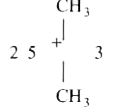Passage-3
Soaps are the detergents used since long. Soaps used for cleansing purpose are sodium or potassium salts of long chain fatty acids such as stearic acid, palmitic acid. These cannot be used with hard water. Synthetic detergents are cleansing agents which have all the properties of soap but which actually do not contain any soap. These can be used both in soft water and hard water as they give foam even in hard water.
Which is not true for a detergent molecule ?
It has a non polar organic part and a polar group
It has a surface active reagent
It is a sodium salt of a fatty acid
It is not easily biodegraded
The correct Answer is:C
Similar Questions
Knowledge Check
Passage-3
Soaps are the detergents used since long. Soaps used for cleansing purpose are sodium or potassium salts of long chain fatty acids such as stearic acid, palmitic acid. These cannot be used with hard water. Synthetic detergents are cleansing agents which have all the properties of soap but which actually do not contain any soap. These can be used both in soft water and hard water as they give foam even in hard water.
Which of the following is called invert soap?ASodium stearateBCetyl trimethyl ammonium bromideCSodium lauryl sulphateDTetraethyl ammonium chloridePassage-3
Soaps are the detergents used since long. Soaps used for cleansing purpose are sodium or potassium salts of long chain fatty acids such as stearic acid, palmitic acid. These cannot be used with hard water. Synthetic detergents are cleansing agents which have all the properties of soap but which actually do not contain any soap. These can be used both in soft water and hard water as they give foam even in hard water.
Which one of the following is not a surfactant?A BCH3(CH2)4CH2NH2CCH3−(CH2)16CH2OSO−2Na+DOHC−(CH2)4CH2COO−Na+
BCH3(CH2)4CH2NH2CCH3−(CH2)16CH2OSO−2Na+DOHC−(CH2)4CH2COO−Na+Soaps are the detergents used since long. Soaps used for cleansing purpose are sodium or potassium salts of long chain fatty acids such as stearic acid, palmitic acid. These cannot be used with hard water. Synthetic detergents are cleansing agents which have all the properties of soap but which actually do not contain any soap. These can be used both in soft water and hard water as they give foam even in hard water.
Which of the following is called invert soap?ASodium stearateBCetyl trimethyl ammonium bromideCSodium lauryl sulphateDTetraethyl ammonium chloride
Soaps are the detergents used since long. Soaps used for cleansing purpose are sodium or potassium salts of long chain fatty acids such as stearic acid, palmitic acid. These cannot be used with hard water. Synthetic detergents are cleansing agents which have all the properties of soap but which actually do not contain any soap. These can be used both in soft water and hard water as they give foam even in hard water.
Which one of the following is not a surfactant?
View SolutionSoaps are sodium or potassium salt of long chain fatty acids like
View SolutionAny compound fonned by the reaction of a water insoluble fatty acid with a metallic radical or with an organic base may be called as soap. Soaps used for cleaning purpose are sodium or potassium salts of long chain fatty acids, e.g., palmitic, lauric, stearic and oleic acids. Soaps arc generally obtained by the hydrolysis of oils and fats with aqueous alkali. This reaction is called saponification
Synthetic detergents are cleansing agents which have all the properties of soaps, but they actually do not contain any soap. A synthetic detergent is the sodium salt of a long chain alkyl hyydrogen sulphate or the sodium salt of a long chain benzene sulphonic acid.
Sodium salts of higher fatty acids are known as:
View SolutionAny compound fonned by the reaction of a water insoluble fatty acid with a metallic radical or with an organic base may be called as soap. Soaps used for cleaning purpose are sodium or potassium salts of long chain fatty acids, e.g., palmitic, lauric, stearic and oleic acids. Soaps arc generally obtained by the hydrolysis of oils and fats with aqueous alkali. This reaction is called saponification
Synthetic detergents are cleansing agents which have all the properties of soaps, but they actually do not contain any soap. A synthetic detergent is the sodium salt of a long chain alkyl hyydrogen sulphate or the sodium salt of a long chain benzene sulphonic acid.
Soaps can be classified as :
View SolutionAny compound fonned by the reaction of a water insoluble fatty acid with a metallic radical or with an organic base may be called as soap. Soaps used for cleaning purpose are sodium or potassium salts of long chain fatty acids, e.g., palmitic, lauric, stearic and oleic acids. Soaps arc generally obtained by the hydrolysis of oils and fats with aqueous alkali. This reaction is called saponification
Synthetic detergents are cleansing agents which have all the properties of soaps, but they actually do not contain any soap. A synthetic detergent is the sodium salt of a long chain alkyl hyydrogen sulphate or the sodium salt of a long chain benzene sulphonic acid.
Which one is not a glyceride?
View Solution
